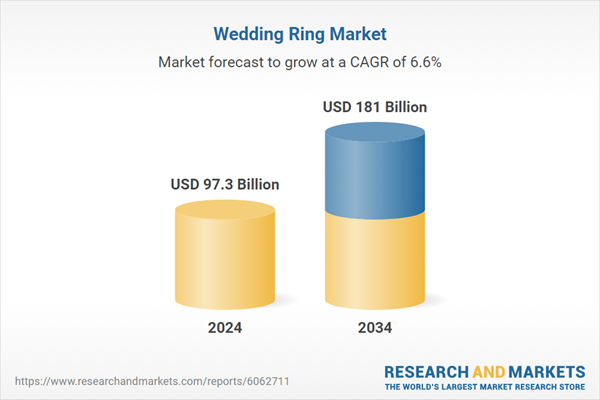The Global Wedding Ring Market was valued at USD 97.3 billion in 2024 and is projected to grow at a CAGR of 6.6% from 2025 to 2034. The increasing demand for personalized and unique designs has significantly fueled the growth of the wedding ring industry. Consumers are now shifting toward custom designs that offer exclusivity and reflect personal tastes. This shift has encouraged jewelers to expand their material options, incorporating not just traditional metals like gold and platinum but also alternative materials such as titanium and tungsten.
Higher disposable incomes and increased spending on luxury items have further driven market growth, with a notable rise in consumer spending on wedding rings in recent years. Many consumers are opting for branded rings, reflecting a trend toward high-end designs that resonate with status and prestige. Additionally, the rising demand for custom designs among younger generations, including millennials and Gen Z, is playing a critical role in shaping market trends. These consumers prefer high-quality, customized pieces that align with their desire for uniqueness and quality craftsmanship. Jewelers have adopted advanced manufacturing technologies that streamline custom fabrication, reducing production time without compromising quality.
The wedding ring market is segmented by material type into gold, platinum, silver, and other materials such as titanium. Gold dominated the market, generating USD 50.2 billion in 2024, and is expected to reach USD 90.7 billion by 2034. Gold remains the most preferred material due to its symbolic significance and timeless appeal. Its adaptability in design makes it popular among a diverse range of consumers across various demographics, ensuring a consistent demand. As gold continues to capture a significant portion of the global wedding ring market, its enduring popularity is expected to sustain future market growth.
In terms of pricing, the market is divided into economic, mid-range, and luxury segments. The mid-range segment accounted for 40.5% of the market share in 2024 and is projected to grow steadily through 2034. This segment caters to consumers seeking high-quality rings within a reasonable price range, typically between USD 1,000 and USD 5,000. Mid-tier wedding rings are often crafted from premium materials such as gold and diamonds, making them attractive to couples who seek elegance without exceeding their budget. The affordability of these options, coupled with their quality and aesthetic value, contributes to the sustained demand for mid-range wedding rings.
In the United States, the wedding ring market is experiencing a growth rate of 6.4% annually, maintaining its dominant position on the global stage. Cultural emphasis on engagements and weddings continues to drive consumer spending on wedding rings, with a notable shift toward customized and high-value rings. The United States benefits from the presence of established jewelry brands and innovative marketing strategies, particularly through online platforms. The evolving consumer preferences and technological advancements in jewelry design and manufacturing are expected to sustain the growth momentum of the wedding ring market in the United States and beyond.
This product will be delivered within 2-4 business days.
Higher disposable incomes and increased spending on luxury items have further driven market growth, with a notable rise in consumer spending on wedding rings in recent years. Many consumers are opting for branded rings, reflecting a trend toward high-end designs that resonate with status and prestige. Additionally, the rising demand for custom designs among younger generations, including millennials and Gen Z, is playing a critical role in shaping market trends. These consumers prefer high-quality, customized pieces that align with their desire for uniqueness and quality craftsmanship. Jewelers have adopted advanced manufacturing technologies that streamline custom fabrication, reducing production time without compromising quality.
The wedding ring market is segmented by material type into gold, platinum, silver, and other materials such as titanium. Gold dominated the market, generating USD 50.2 billion in 2024, and is expected to reach USD 90.7 billion by 2034. Gold remains the most preferred material due to its symbolic significance and timeless appeal. Its adaptability in design makes it popular among a diverse range of consumers across various demographics, ensuring a consistent demand. As gold continues to capture a significant portion of the global wedding ring market, its enduring popularity is expected to sustain future market growth.
In terms of pricing, the market is divided into economic, mid-range, and luxury segments. The mid-range segment accounted for 40.5% of the market share in 2024 and is projected to grow steadily through 2034. This segment caters to consumers seeking high-quality rings within a reasonable price range, typically between USD 1,000 and USD 5,000. Mid-tier wedding rings are often crafted from premium materials such as gold and diamonds, making them attractive to couples who seek elegance without exceeding their budget. The affordability of these options, coupled with their quality and aesthetic value, contributes to the sustained demand for mid-range wedding rings.
In the United States, the wedding ring market is experiencing a growth rate of 6.4% annually, maintaining its dominant position on the global stage. Cultural emphasis on engagements and weddings continues to drive consumer spending on wedding rings, with a notable shift toward customized and high-value rings. The United States benefits from the presence of established jewelry brands and innovative marketing strategies, particularly through online platforms. The evolving consumer preferences and technological advancements in jewelry design and manufacturing are expected to sustain the growth momentum of the wedding ring market in the United States and beyond.
Comprehensive Market Analysis and Forecast
- Industry trends, key growth drivers, challenges, future opportunities, and regulatory landscape
- Competitive landscape with Porter’s Five Forces and PESTEL analysis
- Market size, segmentation, and regional forecasts
- In-depth company profiles, business strategies, financial insights, and SWOT analysis
This product will be delivered within 2-4 business days.
Table of Contents
Chapter 1 Methodology & Scope
Chapter 2 Executive Summary
Chapter 3 Industry Insights
Chapter 4 Competitive Landscape, 2024
Chapter 5 Market Estimates and Forecast, by Material Type, 2021-2034 (USD Billion) (Million Units)
Chapter 6 Market Estimates and Forecast, by Consumer Group, 2021-2034 (USD Billion) (Million Units)
Chapter 7 Market Estimates and Forecast, by Price, 2021-2034 (USD Billion) (Million Units)
Chapter 8 Market Estimates and Forecast, by Stone Type, 2021-2034 (USD Billion) (Million Units)
Chapter 9 Market Estimates and Forecast, by Distribution Channel, 2021-2034 (USD Billion) (Million Units)
Chapter 10 Market Estimates & Forecast, by Region, 2021-2034, (USD Billion) (Million Units)
Chapter 11 Company Profiles (Business Overview, Financial Data, Product Landscape, Strategic Outlook, SWOT Analysis)
Table Information
| Report Attribute | Details |
|---|---|
| No. of Pages | 225 |
| Published | March 2025 |
| Forecast Period | 2024 - 2034 |
| Estimated Market Value ( USD | $ 97.3 Billion |
| Forecasted Market Value ( USD | $ 181 Billion |
| Compound Annual Growth Rate | 6.6% |
| Regions Covered | Global |
| No. of Companies Mentioned | 16 |









